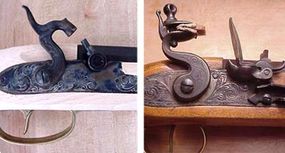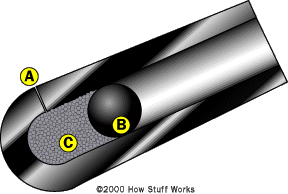Gun Basics and History
To understand how a revolver works, it helps to know something about guns in general. Almost every gun is based on the same simple concept: You apply explosive pressure behind a projectile to launch it down a barrel. The earliest and simplest application of this idea is the cannon.
A cannon is just a metal tube with a closed end and an open end. The closed end has a small fuse hole. To load the cannon, you pour in gunpowder (a mixture of charcoal, sulfur and potassium nitrate), and then drop in a cannonball. The gunpowder and cannonball sit in the breech, the rear part of the bore (the open space in the cannon). To prepare for a shot, you run a fuse (a length of flammable material) through the hole so it reaches down to the gunpowder. To fire the cannon, you light the fuse. The flame travels along the fuse and finally reaches the gunpowder.
Advertisement
When you ignite gunpowder, it burns rapidly, producing a lot of hot gas in the process. The hot gas applies much greater pressure on the powder side of the cannonball than the air in the atmosphere applies on the other side. This propels the cannonball out of the gun at high speed.
The first handheld guns were essentially miniature cannons; you loaded some gunpowder and a steel ball and lit a fuse. Eventually, this technology gave way to trigger-activated weapons, such as the flintlock gun and the percussion cap.

Flintlock guns ignited gun powder by producing a tiny spark, while percussion caps used mercuric fulminate, an explosive compound you could ignite with a sharp blow. To load a percussion-cap gun, you poured gunpowder into the breech, stuffed a ball in on top of it, and placed a mercuric fulminate cap on top of a small nipple. To fire the gun, you cocked a hammer all the way back and pulled the gun's trigger. The trigger released the hammer, which swung forward onto the explosive cap. The cap ignited, shooting a small flame down a tube to the gunpowder. The gunpowder exploded, launching the ball out of the barrel. (Check out How Flintlock Guns Work for more information on these weapons.)
In the 1800s, the percussion-cap gun slowly gave way to the revolver, which only had to be reloaded every five or six shots instead of after each shot. In the next section, we'll see how this system works.
